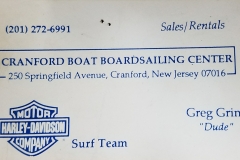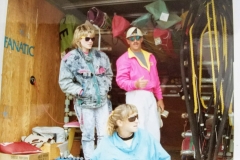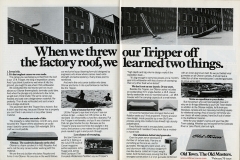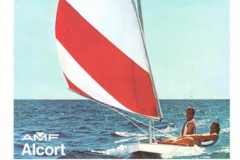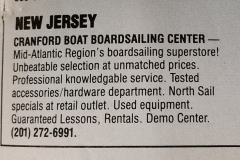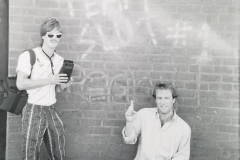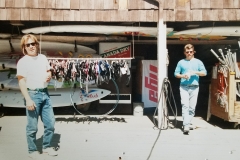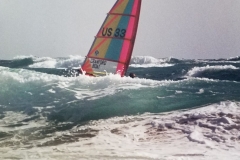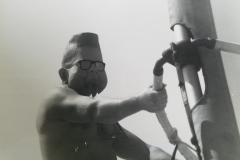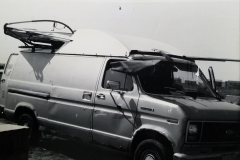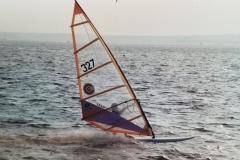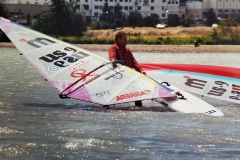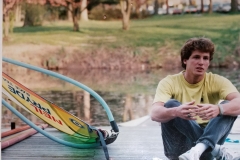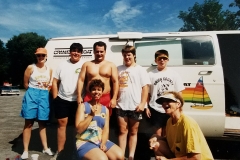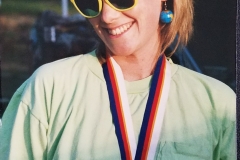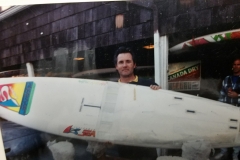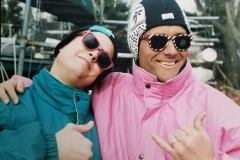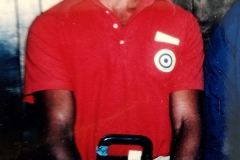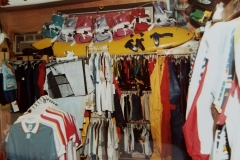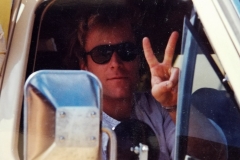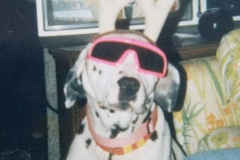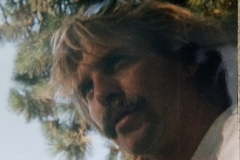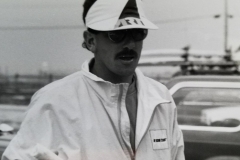
The Mr. Local History Project is determining interest to nominate the Cranford Canoe Club to the New Jersey Historic Registry. If you believe this should be done, please consider signing our petition to let Cranford local officials that this should be done. Click Here.

When you’re a kid, the simplest things in life often end up being the ones you remember the most. As one of three kids in my family growing up in nearby Westfield, New Jersey, the Cranford Boat and Canoe Company, also known as the Cranford Canoe Club, brought life lessons and friendships that live with me almost daily. With all the experiences, workers, friends, and family, the Cranford Canoe Club will never be forgotten. I started working at the Cranford Canoe Club in 1972 and continued until our family sold it in 1990, marking its last private ownership. Here’s my story.
One More Plug – A New Keepsake to Remember the Canoe Club


Cranford Canoe Club History
The Cranford Canoe Club is an iconic historic landmark on the corner of Springfield and Orange Avenue in Cranford, New Jersey. Cranford is a middle-class suburban town in Union County, New Jersey, situated around the slow-moving, winding Rahway River, a tributary that empties into the Arthur Kill Bay in Staten Island.
Documents date back to 1886, when canoe clubs in Cranford were established. However, since I created this pin in the late 1980s, I must give a big shout-out to that project. The club we bought was built in April 1908 and dedicated in May of the same year. If you didn’t know, Cranford is nicknamed “The Venice of New Jersey”. Yes, it’s true. People have enjoyed paddling canoes on that section stretching from the Hansel Dam up to the Riverside Bridge near Nomahegan Park and Union County College. As I remember, it’s about a mile each way and takes almost two hours to complete. The river winds mostly through people’s backyards and is quite rural once you leave the dock. It’s a very serene experience. Kids absolutely love it.
Photo Credit: Arcadia Publishing – Cranford Vol.2
Since the early 1900s, river festivals, flotillas, and boat parades have occurred off the canoe club dock. Major town-wide community events were typically held on the Fourth of July and Labor Day, when 100 residents would gather to participate in boat races, culminating in the Marathon, the ultimate race. Today, residents celebrate with canoes at the Canoe Club on July 4th every year with various group races and the final championship marathon.
It Started In My Parents’ Garage
My story began not at the Cranford Boat and Canoe Company. It actually began in a garage on East Broad Street in Westfield, New Jersey, where I moved in 1968 when I was in Kindergarten. My parents likely moved there because my mom and dad had grown up in Westfield. My mother actually grew up three doors down from where we moved.
My dad, Frank Betz, loved sailing and had dabbled in the Caribbean and other places. Then he had an idea. An idea that I must have heard a thousand times. Every time I heard it, I’d shake my head in agreement since it made perfect sense. Frank would say: “You want to buy a boat where you live, not where you sail.” Frank had gotten a company to sell him a product and deliver it to our garage, where he’d move his product. Guess he was right, cause they were buying boats out of our garage. The first product I remember him selling was a boat called The Sunfish, one of the most popular production boats ever created.
Out of this garage in the late 1960s, my dad became one of the largest dealers in the Northeast. As I found out, selling these boats came with a cost. You see, each boat came in a box. Man, there was a lot of cardboard. The 14-foot boat was delivered in a box, and the customer didn’t want the box. Each boat was equipped with 70 square feet of garbage storage. Someone had to fold and cut up the cardboard. And the garbage men were not happy on Monday after our weekend deliveries!
Getting My Feet Wet at The Pocono Boathouse

The details are a bit sketchy, but there came a point in 1965 when my parents made the decision to buy and build two lots in the Poconos, a mountain area about 100 miles west of New York City often referred to by my dad as “the Ginnea Alps.” It seems that many Italian American Staten Islanders staked a claim in the Pocono Mountains, as it was a straight shot from Staten Island via Route 22 west. My parents heard about a new, two-mile-long man-made lake community that is under development. It was Lake Naomi in beautiful Pocono Pines. The developer was Logan Steele, a Summit, New Jersey resident who built the initial 2-mile lake and community and dug out a two-mile lake but also added a yacht club, six beaches, a community center, a pool complex, and all the roads. He later went on to build other lake communities in the Poconos. I will always remember that Mr. Steele named all the streets after the same street names in Summit (weird). I laugh every time I have to go to Summit.
My parents decided to buy two lots and build homes off Lake Naomi. The first was a chalet-style home. The second was an A-frame model they constructed next door. Then the idea hit. Maybe he could start a boat dealership with a storefront in Pocono Pines, PA to support the growing population. Lake Naomi in Pocono Pines was a no-motor lake, so only sailboats, canoes, and rowboats were allowed. It used to piss off my Uncle Howard every time he wanted to bring up his boat and go fishing.
So my dad went for it. He started the Pocono Boathouse, and as his idea expanded, so did his inventory and staff. My father’s day job, as a Chemical Bank executive in New York City, continued during the week. He would drive up after his Westfield garage boat deliveries were complete usually late Friday night. Back in the 1960s, fathers would typically have their wives and kids go to the lake for the entire season, and they would come up every Friday night to spend the weekend with the family.
Dad hired a couple that grew up in California to run the place. Never really did understand why he hired a windsurfing champion from California to run a business in the Poconos because it must have been a big shock to the system. The Pocono Boathouse started selling Grumman canoes, Duranautic row boats, Hobie Cats, Sunfish, Minifish, Force 5s, Windsurfers, Sunflowers, Mayflowers, Wildflowers, Dusters, and even Columbia bicycles, including the tandem model.
Image Above: Those are our pedal boats out there at Mount Airy in the Poconos (late 1960s)
I recall a humorous story from when he took our family to Mount Airy Lodge as kids and pitched the Lodge Management on why they needed pedal boats. Mount Airy Lodge, as I remember, was a pretty cheesy-looking place. You know, you can’t have enough champagne bubble baths without going for a pedal boat ride. He did sell them a fleet of pedal boats, though!
With the Pocono Boathouse up and running as a seasonal business, it’s where I got my first job. The Pocono Boathouse was located next to the Pocono Pines post office, in what I recall as concrete stables for horses (or storage). We moved into an old vacant barn in the nearby Pocono Preserve a few years later. Some also referred to it as “The Crest or Pocono Crest.” Each day, I’d ride my bike about a mile to meet the manager, Bob Hackenberg, and help pull open the rickety barn doors to our horse-smelling indoor showroom. The barn was so big we had about six boats in there with their sails up. On the right was our inventory storage room, and to the left was our workshop. On the right was our inventory storage room, and to the left was our workshop. We also had a bike rental business full of Columbia three-speeds and these huge white tandems. Seeing a nice young couple walk up together to rent a tandem was the funniest thing. Just about every time they came back in a bad mood. Seems that no matter how you sort it out, a couple on a tandem is a recipe for disaster!
Photo: The Sunfish, supplied by the Pocono Boathouse and our garage in Westfield, became the most popular fleet on the lake (and ultimately the region).
When my father came up on the weekends, he would teach my brother and me how to sail. Entering my first father/son regatta when I was 6, I got so frustrated I remember getting super frustrated at the fluky lake winds and my father barking commands. Naturally, I cried. But all was good in the end when my father guided us to the win. My first sailing trophy. From then on, I was a sailor. (I still have the trophy in my basement today.) In 1975, with lots of practice and hearty competition with my brother Brian, I won the Owaissa Cup and was recognized as the junior champion. You only get to win it once, and I followed in my brother’s footsteps since he had won the year before. The Owassia Cup is named after Camp Owassia, a summer camp located on Lake Naomi since 1920. Our family had become close with the Skinner Family (Ned, Nancy, and Loompie the dog).
Brian and I would compete against each other in the Sunfish class for over a decade. While he often beat me, we finally reached equal status at one point. It was the only sport in which we competed on equal terms. We raced all over the Pocono Mountains, New Jersey, and concluded our racing careers down at Shore Acres Yacht Club with our friend, Read Hayward. Brian went on to play football in high school, and I remember him getting flak from the football coach when he said he had to go to a regatta. “Hey team, Brian needs to go yachting this weekend. What do you all think?” He never mentioned sailing to the coach again, considering Westfield was on a 4-year state championship run.
Cranford Boat & Canoe Company and The Canoe Club
Things got real in 1972 when my father told my mother that the Cranford Canoe Club was for sale. You probably could guess the sales pitch he made to her. She was against it. He was going to quit his job. They had just my baby sister, and my mother was concerned he’d never be around. In the end, he got what he wanted.
My father connected with Mari Becker, a real estate associate with MacPherson’s Realty in Cranford. Mari Becker pitched and ultimately sold the Cranford Boat and Canoe from then-owner George Apgar to Frank Betz. It’s funny that Marie Becker later retired and moved near the original Pocono Boathouse on Lake Naomi in PA.
It didn’t take long for my dad to quit his steady paycheck at the prestigious Chemical Bank and establish himself as a suburban boating entrepreneur.
Cranford Boat and Canoe Company in 1978
George Apgar sold the Cranford Boat and Canoe Company to Frank Betz in 1972.
George was a Cranford resident and had five daughters and five sons,
George, Jr., James, Jonathan, Harvey, and Thomas.
The old canoe club didn’t know what it was getting into, but over the next few decades, Cranford Boat & Canoe Company became one of the most well-known small boat dealerships in the United States. I no longer had a summer job. I now had a job every day. On my bike, I’d ride from Westfield over to Cranford. I remember my first paycheck, which paid a whopping $2.50 per hour, a significant raise from my summer job at the Pocono Boathouse, where I earned about $1.25/hr. It didn’t seem bad at the time, but with all that experience, I think my dad got the best deal on that.
So in 1972, the journey began. My father didn’t take long to expand the Canoe Club with a bigger vision. He created a corporation to support his various associated entrepreneurial endeavors. So an umbrella corporation was created. The umbrella was called Force Four Marine Corporation, named after a wind velocity scale called the “Force system”. Under that umbrella would be the Cranford Canoe Club, Aloa Marine, Hydron Industries, Pocono Boathouse, Regatta Sports, Cranford Boat Board Sailing Center, Sails by Mail, and possibly others I was not aware of. Nevertheless, all the activities took place at 250 Springfield Avenue in Cranford, New Jersey.

The canoe rental/livery business continued throughout our ownership. It was the cash cow so to speak. Schools and camps would visit, and residents would drop by for a quick paddle. The Cranford Recreation Department held the 4th of July river celebration every year we were there. Advertising was fairly limited since it was an iconic place, but I recall one amusing story. Before telling the story, you must understand that my father had a pretty warped sense of humor. It’s sad to say it passed on to me. So, just before Mother’s Day, one year early in our ownership, my father cut a radio advertisement with a big radio station to tell people to bring their mother-in-law down to the Canoe Club to take them for a ride. But at the end of the ad, he said, “Take your mother-in-law for a canoe ride. We won’t tell if you don’t bring her back.” The joke didn’t go over very well because I remember phone calls stating that the National Organization of Women would picket and boycott the Canoe Club. They never showed up, but they called a lot. Don’t think he ever ran radio ads like that again.
Don’t Mess with the Bosses
Things everyone learned at the canoe club taught life lessons. One was that there was a pecking order, and you needed to respect it. However, being the owner’s son, I sometimes took a shot at the bosses because I was the owner’s son and probably felt privileged. In hindsight, it never worked. Ultimately, I liked them all, but I would often tease and challenge the boundaries.

Then I’d find myself thrown in the river and then given a great task to complete. Some of the tasks included raking the stones in the yard so it looked like a perfectly vacuumed living room. And you had to pick up every cigarette butt, pulled soda tab, and any weeds around the perimeter. Any rookie who signed on to work at the Canoe Club got to do that. Picking weeds? It is a daily occurrence when you finish everything else. It was like being a plebe in the Navy.
Another lesson is that most of us never knew there was a right way and a wrong way to load a soda machine. God forbid you do it wrong and it jams. How about how to pull a canoe from the water to the top of the dock (over 15 feet) using a huge metal hook and one jerking moment? Flip off the bridge – no problem. And finally, how can you avoid getting thrown in the river? You could only avoid getting thrown in the river if you were a fast runner. But you could never get out of what was known as the “sweaty forearm.” Once that big guy got his arm around your face from behind, you were going in the river guaranteed!
The Thunder Chicken Challenge
Every company needs vehicles to keep the business running. One activity for those with a driver’s license was to travel to some of our suppliers to pick up boats and bring them back to Cranford Boat. Now, you’d think it’s no big deal, but my father referred to his fleet of cars as Thunder Chickens.

The staff would take these rides and put them through tremendous pain by traveling to our manufacturers and picking up inventory. Through the years we had a challenge; who could bring back the most product without crashing or flipping over the trailer? While there were a few accidents, no one died. But we did get a few shots of some of the success stories. The fleet was started with a 1967 Chrysler station wagon that my father bought for my mother. I did some digging and found a few photos from back in the early 70’s that are in the photo gallery.
The Canoe Club Family
For the next twenty years, I dedicated my life to what I would call the family business. The employees at the canoe club were more than just workers; they were my extended family. These people were like my brothers and sisters—well, except for my brother Brian, who gave the family business a try in the mid-80s and then moved on.
While I was often referred to as the owner’s kid, little shit, and peon, I was just another worker and subject to more abuse (and torture) than any other worker at the bottom of the hierarchy. The senior staff. led by Bob Deen and Tom Sloan. created the workers union, the CCWA which stood for the Canoe Club Workers Association or the “Canoe Club Workers of America”. I remember getting into the CCWA, which was one of the most difficult experiences of my life. More like a college fraternity, the CCWA was just one of those reasons why you loved working with these people.
Frank often used the term “dangerously dumb” to describe one person I remember, and he would always put his arm over the back of his head when discussing details with another. Managing day-to-day operations wasn’t really his thing. He was the company visionary, the idea man. As for the operation, it was the list of people who made the Cranford Boat function for almost 20 years. I’ll call it the C Boat Wall of Honor.
Back in the 1970s, I asked my parents for a camera. When I was, I think, 10, I got one. For years, I had worked to capture images and even considered it as a college major. I was fortunate to have had photos taken during a time when most people didn’t take pictures. So I did some digging, found a few photo boxes, and wanted to share with readers. If anyone has more images, please let us know. We’d love to add everyone. Click Here to email us a photo.
Click Here to see the photo album
Canoe Club Workers of America
The Canoe Club Workers of America (CCWA) was an association founded by Bob Deen and Tom Sloan, which I recall. This secret order held special, closed-session meetings, granted favors, gave preferential treatment, and, above all, provided protection from anyone who wanted to harm the staff for getting them in trouble.
When looking back at some of the great people I worked with as a kid, it’s remarkable how many successes they have achieved after leaving the Canoe Club. Secret Service Agents, Hedge Fund Founders, Corporate Executives, Wall Street traders, and entrepreneurs are just a few professions of my former Canoe Club family. The one thing that remains from the experience is the fact that these kids all got up, got off their asses, and went to work. I just can’t imagine what my life would have been like today if I didn’t have those life lessons by starting a job when I was 8 years old.
[huge_it_gallery id=”1″]
| Bob Deen (CCWA Co-Founder)** | Rick Hoolko * – San Diego Sailing Center |
| Tommy Sloan * * (CCWA Co-Founder) – Retired Secret Service Agent/Author | Barbra Gigon |
| Bob Sloan * | Jim O’Brien * |
| Steve Cannon * | Peter Hogan |
| Albert DiGiovoni | Bill Peters |
| Charlie Rahn | George Apgar |
| Tommy Sgroi * | Read Hayward * |
| Lynn Ochengertis (the Stripper Secretary) | Brett Hartnett |
| Dave Hansen (Sin Bin) | Lori Bailey |
| Kevin Ward | Skip and Karen Harrison (Pocono Boathouse) 1975 North America Windsurfing Champion |
| Bob Hackenberg (Pocono Boathouse) | Steve Hackenberg (Pocono Boathouse) |
| Brooks Betz * (1972-1994) | Brian Dooley * |
| Mike Dunnigan * | Mary Dooley |
| Mo Dooley * | Patrick O’Brien* (1977-1981) |
| Brian Betz (1984-1985) | Read Hayward’s nephew |
| Jeffrey Brownlee (86-87ish) | Steve Henry (Pocono Boathouse) |
| Rob Espuga | John Lorenz |
| Jim Barton * | Tom Bevan * (Last CCWA inductee) |
| Tim Rahn | Tim Byrd |
| Billy Weber | Jon Weber |
| Ted Willis | Ross Hirtzel |
| John Gatens | Carolyn Betz (Wenzel) (1990-1998?) |
| Read Murphy (Regatta Sports) | Sue Gertz (Regatta Sports) |
| John “Swatty (Regatta Sports) | Larry Fineberg (Regatta Sports) |
| John Korn | Frank Bradley |
| Brian Mack | Eric “Mack” MacNamara and his twin brother |
| Scott ___________ | Greg Elmiger |
| Mike Osborne | Tim Rahn |
**CCWA Co-Founder *CCWA member
Cranford Boat Firsts
I know it’s going to sound strange but there were a lot of “firsts” that could be claimed at the land-locked Cranford Boat and Canoe Company. I can’t count the times my father would travel, find something cool, and decide that he’s going to become a dealer and be the first to sell them to make a mint. Did you know Cranford Boat was:
- The first Windsurfer brand dealer east of the Mississippi River
- First Hobie Cat Dealer in the area.
- Became the largest dealer for Windsurfer Brand sailboards east of California.
- First to take a Baja Windsurfer through customs in Jamaica (they thought it was a Marijuana ploy) 1972
- First US importer of Beken of Cowes calendars that sold for $20 in the era of the free bank calendar
- First importer of a French yacht builder with the Aloa 29 and Aloa 34 yachts. Actually put the 29′ in the parking lot.
- One of the original importers of Victorinox Swiss Army knives. Imported a ton, but never sold many though (kept being taken by the staff)
- First importer in the area for motorized Bermuda Bikes, later Snark Mopeds (none survived the staff use)
- First to import an underwater Aquascooter hovercraft that was used in the Rahway River
- Youngest salesmen to sell in the Alcort Sunfish booth at the New York International Boat Show
- First to put deer hooves in boats at the New York Boat Show
- First O’Neill wetsuit dealer in the area.
- First to sell the ever-popular “Bo Knows Your Sister” T-shirt from the store’s front window.
- First beach shop store in Cranford.
- First Oakley dealer in northern New Jersey
- First to teach an MTV Veejay (Kevin Seal) how to Windsurf on television
- First hydrofoil dealer for the Windsurfer hydrofoil
- The first Powell skateboard shop in Cranford
- First to create a national sailboat and windsurfing parts catalog (1991)
- First company from New Jersey to sponsor semi-professional windsurfing team (in Hood River, OR)
- First to have an Olympic Bronze Medalist on the dock at the Canoe Club (1992) Mike Gebhardt
- First to put on a boat show inside a mall (the Woodbridge Mall)
- First to bring a Snark sailboat to the New York International Auto Show (strange but true)
- Had various DBAs: Force Four Marine Corporation, Pocono Boathouse, Cranford Boat, Aloa Marine
Work Challenges/Entertainment and Other Memories
While the Cranford Boat and Canoe Company is no more, the Cranford Canoe Club livery operation lives on in Cranford. The public comes, the floods come, and the river meanders on. But for a short time in history, I got to live my life with my family on what we comically called “the mighty Rahway River.” video of the second-biggest flood in Cranford’s history (July 1975) was found on YouTube. The only one that was worse was the one in 1973. Yep, we owned it.
Life Lessons
The one thing I can’t escape is the daily habits I developed while working at the canoe club. Whether it’s tying a bowline knot or telling someone to pick up their cigarette butt, it’s amazing how many things I learned to do by just doing them.
How many people know how to tie something down on the roof of your car? Everyone who worked at the Canoe Club would know. The bowline then goes over the item, through a hook or bar, back up to a slipknot, ending with a few rolling 1/2 hitches. Boy Scouts have nothing on Canoe Club workers.
After probably 30 years, I researched and found Rick Hoolko, one of the earliest employees in the 70s. When I called, it was like we hadn’t missed a beat. Rick moved to San Diego and founded the San Diego Sailing Center, which operated on Mission Bay for almost 30 years. What struck him, as well as me, is that he took all the life lessons he learned at the Cranford Canoe Club and lived it for 30 years. He stated, “Not a day went by when I wasn’t reminded how lucky I was to run the West Coast version of the canoe club for almost 30 years.” I have to agree, it was a great run, Rick!
I remember some memorable moments for those who worked at the Canoe Club as part of the CCWA.
- Slide of Life is a zip-line slide using the C Boat inventory. It begins at the roof’s pinnacle and extends approximately 150-200 feet across the Rahway River.
- Beat Me with a Paddle Incident – A guest called and later came to have his rear end beaten with a paddle.
- Kegs in the Office After Hours– Something that the younger members of the CCWA never could get right.
- The Waterbury Sunfish Transport Record – the opportunity to have a nervous breakdown while driving over the Tappan Zee Bridge, which had to be an illegal amount of cargo. It got even worse if it rained.
- The Grumman Canoe Transport Record – putting 15-20 canoes on a station wagon or van wasn’t a good idea.
- Driving in Danger—The Thunder Chickens—Cars that were designed to break down and make Whalen’s Garage rich.
- The flood of >>>>>> Nothing was worse than emptying the building and watching the water come in.
- Making changes regarding the soda machine for tennis players —There was only water at the tennis courts across the street daily. For healthy people, I never could understand that I’d have to make changes, probably 20 times a day, for these tennis people.
- The multiple broken front windows and the CPD call at 2 a.m. to get down there—Drive by Smash and Grabs were not fun to deal with.
- Cigarette Butt Pickup Duty – In the 70’s all I can say is that EVERYONE smoked. And you had to go around and pick every one of them up.
- Soda Tab Pickup Duty: Who remembers pulling soda tabs? When you have two soda machines, you have many tabs to pick up.
- Catching Rats – The Rahway River didn’t just have rats, they had BIG RATS. And they loved candy from the candy machine. I’ll never forget the one we found in the bathroom that dug a hole in the sheetrock, screamed at me, and then ran into the hole. It was the size of a cat!
- Beer dispensing from the Soda Machine is a great invention until you forget you did it, and some kid walks by with a beer can.
- Driving the Mopeds—A new shipment came in, and they were put to the test. Remember Sloan riding it across the bridge? Huge amounts of smoke were coming from the muffler.
- Drinking Tahitian Treat because it was the last cold soda selection in the machine- No one still knows what kind of soda that is.
- Retrieving vending machines from the river – It was guaranteed, if we left the cigarette or candy machine out overnight, it ended up being thrown in the river! Not a fun task because you had to go in to retrieve it.
- Giving directions 100 times a day – Need I say more? One of the busiest corners in the area, and with a telephone booth right in the lot, you were bound to have someone ask you for directions at least 5 times a day. The best one was when a guy came in and asked, “How do I get to Union County College and the local mailman replied, “Study.”
- Kerry the UPS Man – Who didn’t love the UPS man? He bought dog treats, slid on our entries, carried out all our crap, and even later gave me and my brother a job!
- Not wanting to touch the Dollar bills after Lynn, the Secretary, came in and cashed her singles for bigger bills.
- Rice pudding from the Town Deli – there was nothing better!
- Hide & Seek – Hiding in the lifejacket room for hours and not getting found.
- The Calendar Folding Record—The calendars we sold were large, and they required a large box. I’ll never forget the competitive spirit of the staff who actually stayed in Westfield on a Friday night, listening to Led Zeppelin and Kashmir, and boxing over 1,000 calendars.
- The Sweaty Forearm – An invention created by Bob Sloan to invoke his will over smaller prey.
- Harold the Mailman was another favorite. He came early, made coffee before we arrived, and even opened up for us a few times.
- Staff headed to the Poconos to hand-sand the A-Frame. Then, they had to go to M&J’s to meet Gerty and drink beer!
- You’re 18—now you get to go to Uncle Charlie’s in Linden and drink flaming shots until you puke on the bar!
- Arm Wresting at the Cranford Hotel
- Antone’s—Late 1980s—If it’s Thursday Night, it’s going down at Antone’s on South Avenue for pool and libations!
- I think the Professional Adjunct Staff was started and led by Read Hayward. It offered free help for discounted gear. You never really knew who you would show up to since he taught “special ed” kids in Plainfield. It evolved and transformed many times, and we couldn’t have survived without it.
- The unsanctioned Windsurfing trips to Florida, Texas (housekeeping), Hatteras, Hood River, the Bay Area, Mexico, and elsewhere.
- The Aloha 29 in the parking lot – treating that boat like it was your late-night bedroom.
- The mall boat shows and the professional adjunct staff (including BNs)—A mall boat show? Really? Set up Sunday night after the mall closes. Work as fast as you can. And bring shorts to grab as many coins as possible from the fountains. Sometimes, you score, and sometimes, the Mall Cop gets you.
- NY, Annapolis, Newport Boat Shows – too many stories to list here. You could just imagine.
- Joining the CCWA would involve a private ceremony and a vote. I can tell you there aren’t many members, and not everyone gets it.
Everyone Had to Move On
Before concluding this post, I wanted to share a few memories that I’ll never forget. In fact, I’ll still laugh (or wince) at everyone that pops into my head. I’m just glad I had the opportunity to participate. I met my wife in April of 1987, and she put up with my shenanigans at Cranford Boat for too long. While we got married in 1991, I finally quit Cranford Boat in May 1994 to “get on with my life and get a real job”, as many had often said. I will never forget those times. We had barely survived the recession of the mid-80s, but I managed the business after my father left to return to work in New York City. I had to attempt to recoup what had escalated to over a million dollars in debt (it’s a long story) due to some friendly banking relationships my father had. But my father did always say, “You want to make a million dollars in the boat business? Start with 2 million and get out fast.”
You see, Frank had many Frankisms he loved to share. Frank seemed to have a great “love/hate” relationship with his customers. You either loved the guy to death, or you couldn’t stand him. But he was the only game in town so if you wanted your boat fixed for the weekend and get your parts, you had to suck it up. In today’s world of internet reviews, we’d be closed in a month.
I’m going to visit the remote satellite store, Regatta Sports, managed by Read Murphy, a local’s local in the area. The remote Cranford Boat experiment took place from 1984 to 1986, located just south of the Sandy Hook Bridge in Sea Bright. That’s a whole other chapter for another time.
In the end, Frank Betz offered to buy the township of Cranford the property and the canoe livery service. It was funny because, during the negotiations with the township, Frank really didn’t want to wait two years for the township to apply for grants to purchase the property. I remember him often saying, “Well, geeze guys, how about I sell the place to the mafia? They’d love to launder their money with cash canoe rentals. And they’ll close immediately!” However, in 1990, they came to terms, and although the process took years to complete, the inventory was either liquidated or relocated to one of Frank’s multiple garages/warehouses on the East Coast. As he moved from Scotch Plains to Greensboro, NC, then to Warren, NJ, and finally to Florida, to this day, almost 27 years later, I bet he still has a stash of Cranford Boat inventory. Heck, I even still have a spool of Marlow rope and all the Sears Craftsman sockets from the business.
I did a lot of traveling as C-Boat started to wind down. Took the company van in the off-season and headed to Florida for training and windsurfing. Then off to the West Coast, including Hood River, Portland, the San Francisco Bay Area, and LA. Had a few stints in Baja windsurfing with friends. Then, I returned to Hatteras and spent a few months at C-Boat to close out my career.
The Family Breakup
Not to get too deep, but in the end, there was a divorce between my mom, Carolyn, and my dad, Frank. Even though I was older, it got really personal and messy. He also chose not to engage well as a grandparent, so he’s no longer part of the core family. No one in the family speaks to Frank anymore for several reasons. So if you ask, “What does Frank have to add?” it would’ve been a lot since he loves to write. On the positive side, I do talk and visit with the rest of my family regularly. Brian’s out in PA, Cee Cee’s in Bradenton, Florida, and my mom, Carolyn, lives happily three doors down from her daughter. Frank Betz passed in 2017. They’re all still part of my life and I’m grateful for that.
What’s Next?
Reunion
There’s a discussion to schedule a CCWA and Professional Adjunct Staff reunion at the Canoe Club. If you’re interested, post a comment, and someone will contact you.
Wikipedia: Cranford Canoe Club
So, not to get too involved with the canoe club’s raw timeline history, I spent a few weeks creating the Cranford Canoe Club Wikipedia Page. I recognize that the Cranford Canoe Club, which my family purchased, was probably the third most popular canoe club in Cranford, but it’s the one that has lasted the longest and is still operating today.
Photos Needed
I just wish I could find more of my photos of so many of you. I’ll keep digging. If you find any good ones, or you were a former worker at the Cranford Canoe Club, we’d love to hear from you.
Cranford Boat – CCWA on Facebook
During my tenure, here’s the list of Cranford Boat people I remember.
For those former employees, there’s now a CCWA Private Facebook Group to connect.
Have a Canoe Club Story to Share?
Post any comments below. I’d love to hear from anyone with a good Canoe Club story. Someday, maybe I’ll write a book or make a movie. Anything’s possible.





